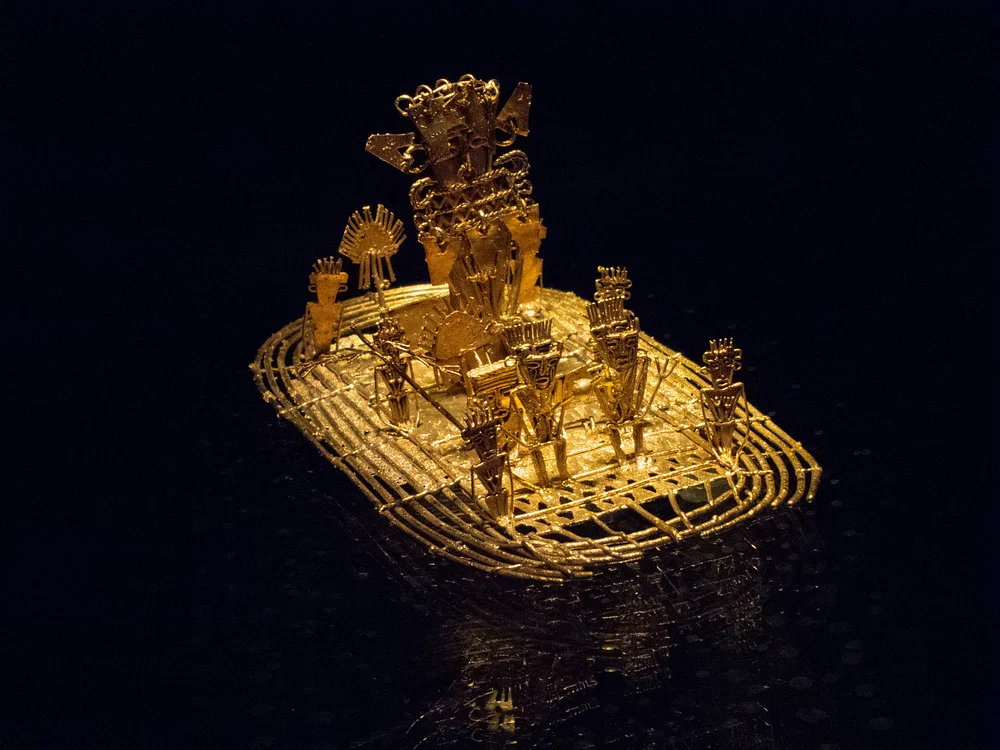Left to right: Huitaca, Chía, Bachué, Sué and Bochica
The Muisca (or Chibcha) civilization flourished in ancient Colombia between 600 and 1600 CE. Their territory encompassed what is now Bogotá and its environs and they have gained lasting fame as the origin of the El Dorado legend. The Muisca have also left a significant artistic legacy in their superb gold work, much of it unrivalled by any other Americas culture.
Society & Religion
The Muisca lived in scattered settlements spread across the valleys of the high Andean plains in the east of modern-day Colombia. Important annual ceremonies related to religion, agriculture, and the ruling elite helped unite these various communities. We know that such ceremonies involved large numbers of participants and included singing, incense burning, and music from trumpets, drums, rattles, bells, and ocarinas (bulbous ceramic flutes). The communities were also linked by trade and there was even a movement of skilled craftsmen, especially goldsmiths, between Muisca cities.
Founded by the legendary figure of Bochica, who came from the east and taught morality, laws, and crafts, the Muisca were ruled by chieftains aided by spiritual leaders. The Muisca controlled and defended their territory with such weapons as clubs, spear-throwers, arrows, and lances. Warriors also had protective helmets, armoured breast plates, and shields. The Muisca took trophy heads from their defeated enemies and they sometimes sacrificed captives to appease their gods.However, warfare was highly ritualized and probably small-scale.
Idolizing the sun, the Muisca also had a special reverence for sacred objects and places such as particular rocks, caves, rivers, and lakes. At these sites they would leave votive offerings (tunjos) as they were considered a portal to other worlds. The most important Muisca gods were Zue the sun god and Chie the moon goddess. We also know of Chibchacum, the patron of metalworkers and merchants.
El Dorado
The Muisca today are most famous for the legend of El Dorado or 'The Gilded One'. A Muisca ceremony held at Lake Guatavita, actually only one of many kinds, involved a ruler being covered in gold dust who was then rowed on a raft to the centre of the lake where he leapt into the waters in an act of ritual cleansing and renewal. Muisca subjects would also throw precious objects into the lake during the ceremony, not only gold but also emeralds.
The Spanish, on hearing this story, allowed their imagination and lust for gold to leap beyond the bounds of reality and soon a legend arose of a magnificent city built with gold.
Muisca Art
The Muisca did not restrict their artistic output to gold but also created fine textiles which were of wool or cotton, and the latter could also be painted.
Typical Muisca designs include spirals and other geometric, inter-locking forms. Also produced were ceramics (including clay figures) and carved semi-precious stones. The Muisca women were not only capable weavers of cloth but were equally skilled in basket-weaving and feather-work.
For the Muisca, gold was though the material of choice as it was valued for its lustrous and transformational properties and its association with the sun. It was not used as a currency, but rather as an artistic medium
Perhaps one of the finest Muisca pieces, and solid evidence of the El Dorado ceremony, is a gold alloy raft on which stand figures, one of whom is larger and, wearing a headdress, is undoubtedly the 'Gilded One'.

Language
Chibcha, Mosca, Muisca, Muysca was a language spoken by the Muisca people of the Muisca Confederation, one of the many indigenous cultures of the Americas. The Muisca inhabited the Altiplano Cundiboyacense of what today is the country of Colombia.
The name of the language Muysc cubun in its own language means "language of the people", from muysca ("people") and cubun ("language" or "word"). Despite the disappearance of the language in the 17th century (approximately), several language revitalization processes are underway within the current Muisca communities. The Muisca people remain ethnically distinct and their communities are recognized by the Colombian state
Under the colonial regime
When the Muisca structure disappeared under the Spanish Conquest, the territory of the Confederations of the zaque and zipa were included in a new political division within the Spanish colonies in America. The territory of the Muisca, located in a fertile plain of the Colombian Andes that contributed to make one of the most advanced South American civilizations, became part of the colonial region named Nuevo Reino de Granada. The priests and nobility of the Muisca were eliminated. Only the Capitanias remained. Much information about the Muisca culture was gathered by the Spanish administration and by authors such as Pedro de Aguado and Lucas Fernández de Piedrahita.
The Spaniards created indigenous areas to keep the survivors, who were obligated to work the land for them under the quasi-genocidal encomienda system. The colonial era contributed to the importance of Bogotá, and people from the area would play an important role in the fights for independence and republican consolidation. The wars of independence of three nations (Colombia with Panamá, Venezuela, and Ecuador) were led by the descendants of aboriginals; Spaniard-affiliated elites were forcibly deported after independence.
Independent Colombia
After independence in 1810, the new state dissolved many of the indigenous reservations. The Reservation of Cota was re-established on land bought by the community in 1916, and then recognized by the 1991 constitution; the recognition was withdrawn in 1998 by the state and restored in 2006.
Since 1989, there has been a process of reconstruction of the indigenous councils by the surviving members of the Muisca Culture. Muisca Councils currently working are Suba, Bosa, Cota, Chía, and Sesquilé. The councils had an Assembly in Bosa on 20–22 September 2002, called the First General Congress of the Muisca People. In that congress, they founded the Cabildo Mayor del Pueblo Muisca, affiliated to the National Indigenous Organization of Colombia (ONIC). They proposed linguistic and cultural recuperation, defense of the territories nowadays occupied by others, and proposed urban and tourist plans. They support the communities of Ubaté, Tocancipá, Soacha, Ráquira, and Tenjo in their efforts to recover their organizational and human rights.
The Muisca people of Suba opposed the drying up of the Tibabuyes wetland and wanted to recover the Juan Amarillo wetland. They defended the natural reserves like La Conejera, part of the Suba Hills that is considered by the Shelter's Council to be communal land. Suati Magazine (The Song of the Sun) is a publication of poetry, literature, and essays about Muisca culture.
The community of Bosa made important achievements in its project of natural medicine in association with the Paul VI Hospital and the District Secretary of Health of Bogotá. The community of Cota has reintroduced the growing of quinua, and regularly barter their products at market.
Megathreads and spaces to hang out:
- ❤️ Come listen to music and Watch movies with your fellow Hexbears nerd, in Cy.tube
- 💖 Come talk in the New Weekly Queer thread
- 💛 Read and talk about a current topics in the News Megathread
- 💚 Come and talk in the Daily Bloomer Thread
- ⭐️ September Movie Nominations ⭐️
reminders:
- 💚 You nerds can join specific comms to see posts about all sorts of topics
- 💙 Hexbear’s algorithm prioritizes comments over upbears
- 💜 Sorting by new you nerd
- 🌈 If you ever want to make your own megathread, you can reserve a spot here nerd
- 🐶 Join the unofficial Hexbear-adjacent Mastodon instance toots.matapacos.dog
Links To Resources (Aid and Theory):
Aid:
Theory:


Try to get into universities, its simplest. getting work permit is very involved, cause if its not company doing it for you, you'll go through bureaucratic hell. Countries have their own immigration sites. like new zealand has a site with workers they need, so you can slowly go through them (look at government sites, not you're 1000th visitor, you win a lottery).
Don't know what decent chunk is, i think chile for example has simple 6 months residency if you can prove you have 20k (kinda like extended touristy stuff, but i think you can work as well with that type of visit).
Universities are great cause they shoulder lots of responsibility with paperwork, in a country where you don't know anything and where to go.
There are a couple of places where you can re-up your visa just by crossing the border and coming back in every x months. That's really fraught, though. They might close the border or something then you're boned.
It does make sense that going to a university would be the simplest choice. As you say, they handle (some of) the paperwork nightmare for you. But I'm sure going to school in another country isn't the end of the road. There's more you'd have to do after. I guess once I'm there it wouldn't be hard to ask for advice from the staff, though. I'm sure they aren't eager to just give somebody a degree and then kick 'em out of the country forever.
Now, idk how universities work really, I've never been to one, never planned to go to one, not sure if I have enough money for all that, etc. Is there another relatively simple route that I'm missing?
I'm close enough, I'll have it before too long. What's that called, do other countries do that sort of thing or did somebody in Chile decide to get weird with it?
I've searched again and couldnt find it:( It was simplified temporary residency or something close.
it was some sort of the tech worker shenanigans somewhere in south america during corona. But maybe they've tightened the standards, because what i know see everywhere, is that you need proof that you work remotely, instead of proof of solvency :(
Lots of universities are free in europe so its like cost of living of 500-700 euros a month, if you dont get scholarship. The bonus of course is that finding work is easier later for permanent relocation.
There is also working holiday visas like this https://www.immigration.govt.nz/new-zealand-visas/visas/visa/united-states-of-america-working-holiday-visa
Upto a year, and no permanent contract so more of fuck around type deal, but with absolutely no guard rails i can see, so you might just not find any work burn money and be dissapointed
Cost says under $500 (in monopoly money, no less), but it also says "from" that amount.
Is that really possible? They'd let me come work in their country for that little? That seems too good to be true. I mean obviously you have to take care of housing and actually finding a job where prospective employers know you won't necessarily be there for the long-term, but that still seems way too easy compared to everything else I've seen from basically every country ever. Can you just renew those? Could you theoretically just permanently chill in New Zealand for like 250 USD a year if you're good enough at finding work?
It's far from my first choice but that ... is a choice. My first choice is hoping my chinese friend has a very desperate friend or family member who will marry me lmao